Ciencia, Economía & Negocios, Vol. 4, No. 1, enero-junio, 2020 ISSN (Impreso): 2613-876X • ISSN (En línea): 2613-8778• Sitio web: https://revistas.intec.edu.do/
Results of the contingent valuation to estimate the environmental impacts caused by rock-ash discharge in the Dominican Republic
Resultados de la valoración contingente para estimar los impactos ambientales causados por la descarga de cenizas (rock-ash) en la República Dominicana
Cómo citar: Gomez-Valenzuela, V., & Alpízar, F. (2020). Results of the contingent valuation to estimate the environmental impacts caused by rock-ash discharge. Ciencia, Economía y Negocios, 4(1), 5-24. Doi: https://doi.org/10.22206/ceyn.2020.v4i1.pp5-24
1. Introduction
This paper is published a little more than a decade after the fieldwork and reports undertaken by the former Secretary of State of Environment and Natural Resources of the Dominican Republic, current Ministry of Environment and Natural Resources, regarding the economic valuation of impacts caused by rock ash deposits in the national territory in 2003 and 2004.
The environmental incidents occurred in 2003 and 2004 in two locations: Samaná and Montecristi (De León, 2009). In 2006, it was commissioned by the Secretary of Environment and Natural Resources, the economic valuation of the environmental impacts caused by rock ash deposits, delivering the final report in 2007. Therefore, this paper has been conceived as a rigorous synthesis of the research, leading to an estimation of the economic valuation of the environmental impacts caused by the 2003–2004 rock ash discharge. To achieve this goal was carried out nonparametric estimation of the willingness to pay (np-WP) through a contingent evaluation exercise.
The Dominican Republic is located in the Caribbean region, occupying two-thirds of Hispaniola Island, and totaling 48,310.97 square kilometers (ONE, 2012). Hispaniola is the second major island of the Greater Antilles, after Cuba, and it has a population of approximately 10.6 million inhabitants (World-Bank, 2017). The Dominican Republic shares the island with the Republic of Haiti. The World Bank reports that the Dominican Republic is an upper-middle-income country with a gross national income per capita of US$6,390 (World-Bank, 2017). In 2016, manufacturing and service activities represented 91.2% of its total economic activity (with the service sector accounting for 61.2% and manufacturing activities for 30%) (Banco-Central, 2017). The Human Development Report considers the country to have high human development (UNDP, 2016). However, historically, the country has had significant social distortions in the areas of poverty and income distribution (Attali, 2010), despite recent achievements in poverty reduction. From 2014 to 2015, extreme poverty declined from 8.4 to 7% of the population, and general poverty declined from 36.4 to 32.3%, according to official estimates (MEPyD, 2016).
This late publication of the results of the contingent valuation obeys to purely academic interest. Its purpose is to recover what may have been the first experience of using the contingent valuation method in the Dominican Republic for a case related to the environment. In the heat of events, the case of rock-ash, as it was known, was highly controversial and mobilized national public opinion. The political, economic, and social situation of the moment affected in a particular way the life of all the actors involved. These results, therefore, do not constitute an evaluation of the actions of public and private persons that were directly or indirectly affected or related to the case.
1.1 The event: rock ash in the Dominican Republic
From the last quarter of 2003 through the first quarter of 2004, approximately 56,845 tons of the byproduct called “rock ash” generated by coal-fired power plants were allowed to be introduced into the Dominican Republic from the AES Corporation facilities in Puerto Rico (Gómez-Valenzuela and Alpízar, 2007, De León, 2009). Around 30,000 tons were allowed to enter the country in October 2003 via the seaport facilities at Pepillo Salcedo, Montecristi, in the northwest part of the country. About 26,000 tons were allowed to enter in March 2004 via the Samaná peninsula in the northeast part of the country (De León, 2009, Gómez-Valenzuela and Alpízar, 2007).
The byproduct generically known as rock ash is the result of burning coal in the furnaces of electricity-generation facilities. It includes two types of residues: bottom ash and fly ash. According to the definition available in the web page of the American Coal Ash Association bottom ash is constituted of “agglomerated ash particles, formed in pulverized coal furnaces, that are too large to be carried in the flue gases and impinge on the furnace walls or fall through open grates to an ash hopper at the bottom of the furnace. Physically, bottom ash is typically gray to black, is quite angular, and has a porous surface structure” (ACAA, 2016). Fly ash is a “fine, powdery substance that ‘flies up’ from the coal combustion chamber (boiler) and is captured by emissions controls, such as an electrostatic precipitator or fabric filter. These materials, primarily fly ash, are virtually identical in its composition to volcanic ash with pozzolanic properties, making it ideal for concrete. However, since 2008, the Environmental Protection Agency of the United States had set up regulations in order to promote its adequate disposal and management because Coal ash contains contaminants like mercury, cadmium, and arsenic. Without proper management, these contaminants can pollute waterways, groundwater, drinking water, and the air” (EPA, 2017a).
The rock ash deposit in Manzanillo (Montecristi) corresponds to the geographical coordinates 19° 42’12’’ LN and 71° 44’ 25’’ LW and covers an area of around 55,967 square meters or 5.5 hectares. The rock-ash deposit in Arroyo Barril, Samaná, corresponds to the geographical coordinates 19º 12’ 00’’ LN and 69º 27’ 10’’ LW and covers an area of around 4,159 square meters or 0.41 hectares. Figure 1 shows the geographic location of both sites in the Dominican territory.
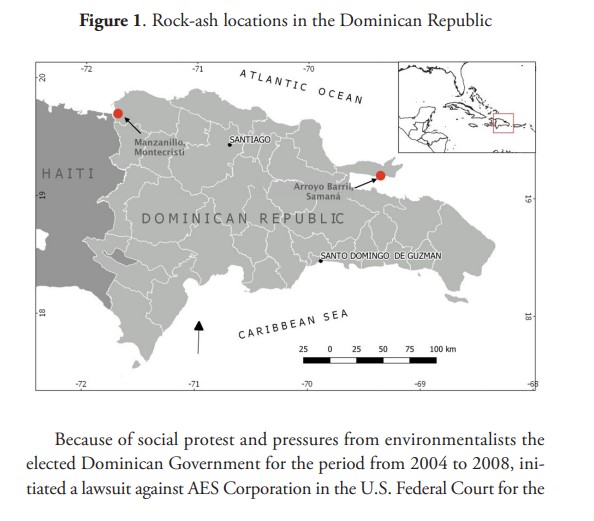
Because of social protest and pressures from environmentalists the elected Dominican Government for the period from 2004 to 2008, initiated a lawsuit against AES Corporation in the U.S. Federal Court for the District of Virginia for the amount of US$80 million. This amount was estimated based on the direct restoration cost provided by technicians from the former Secretariat of Environment and Natural Resources. Nevertheless, in March 2007, an agreement was reached that a settlement of US$6 million would be paid, which was intended for the removal and treatment of rock ash from the affected zones (De León, 2009).
1.2. An overview of contingent valuation
The contingent valuation (CV) method is undoubtedly one of the most popular methods used for assessing environmental impacts. Its formal origins date back to the early 1960s when Robert Davis used it to determine the value of Maine’s forests to local hunters (Davis, 1963). Since then, the method has been used extensively to assess a wide range of risks and environmental impacts. Despite this, a full range of critiques has been levelled against the method because of its theoretical foundations, including the use of surveys and hypothetical markets (Akhtar et al., 2017, Carson, 2012, Hanemann, 1994). The CV method is, therefore, defined as a declared preference method, based on surveys and hypothetical markets, in contrast to the use of revealed preference methods, which are oriented to an indirect approach to the evaluation process (Freeman et al., 2014, Carson et al., 1996).
The CV method has established itself as an environmental assessment tool recommended as one of the methods of measuring environmental benefits and damages in the landmark U.S. legislation entitled the Comprehensive Environmental Response, Compensation, and Liability Act of 1980, also known as the “Superfund” legislation (EPA, 2017b). Furthermore an expert panel of the U.S. National Oceanic and Atmospheric Administration (NOAA), extensively discussed the use of the method, recognizing its strengths and limitations and recommending its use for the economic assessment of the Exxon Valdez oil spill along the Alaskan coast in 1989 (Harrison, 2001, Portney, 1994).
In the case of the Exxon Valdez oil spill (in which around 11 million gallons of oil and close to 10,000 square miles of coastal zone were affected), a CV survey developed by Carson and colleagues determined that the number of monetary damages from the spill reached the original 1990 estimates of US$2.8 billion (Carson et al., 2003). This amount resulted from the aggregation of the average willingness\ to pay (WTP) for the development of a prevention plan, which was estimated at $31 per U.S. household, multiplied by the number of households in the country (Carson et al., 2003).
Harrison (2006) argued that the estimate of the magnitude of the damage of the Exxon Valdez spill oil at US$2.8 billion would be “highly speculative,” meaning that it could be higher or lower depending on assumptions and interpretations of the responses to the CV surveys. This critique, however, refers to the “inferential uncertainty” associated with the method. Taking into account this key epistemological issue, refinements to the CV method have improved the quality of the estimation of WTP and willingness to accept (WTA), and new approaches have emerged to deal with uncertainty while retaining the essence of the CV method (Mahieu et al., 2014, Voltaire et al., 2013).
2. Materials and methods
In order to carry out the CV, three main stages were developed: (i) definition of target population and sample design; (ii) construction of the questionnaire, testing, and fieldwork; and (iii) data processing and statistical analysis (L. Nandagiri, 2015, Whittington, 1998, Carson et al., 2003).
2.1 Target population and sample design
The target population was the Dominican population over 18 years of age, living in different municipalities. A simple random sample design with a probability proportional to population size was chosen (Scheaffer et al., 2011). The resulting sample size was 600 interviews, distributed across different sample points in the country, with ten interviews at each point. The fieldwork was conducted from 10 November 2006 until 6 January 2007.
2.2 CV questionnaire
One of the core components of the CV method is the construction of the questionnaire. In this case, the questionnaire had four components: (i) information about the rock ash deposits; (ii) degree of knowledge about the issue; (iii) economic valuation; and (iv) sociodemographic characteristics.

The question format used in the economic valuation is known as the referendum format or binary format (acceptance-rejection) and was introduced by Bishop and Haberlein (1979). The format asks interviewees to express their WTP a certain amount to ensure improvement or to prevent environmental damage (Liu et al., 2014; Ramajo-Hernández and Saz-Salazar, 2012). Once the interviewee indicated a preference for payment, it follows a question about the maximum amount that he or she would be willing to pay as a way to find his or her reservation price for the environmental good or service and reduce the incentive for the respondent to give a strategic response.
The application of a referendum-type format implied an array of payment proportionately distributed within the sample with different amounts offered to respondents. This array makes it possible to build a monotonically decreasing function from which to derive the WTP according to the proportion of positive responses (Carson et al., 2003, Ramajo-Hernández and Saz-Salazar, 2012). The payout array used here was in Dominican pesos (DOP$), and the suggested amounts were $10, $20, $30, $50, $80, and $110.
2.3 Data processing
The stage of processing and preparation of databases was conducted once the fieldwork and the validation reappraisals were finished. The databases were developed in spreadsheets, and a data capture program was used (Survey System 9.0); the analysis of the results was conducted using SPSS 13.0 and the econometric program LIMDEP 6.
3. Results and discussion
A watching and monitoring program (WMP), which would prevent events like rock ash disposal and allow watching and monitoring of the current disposal, was presented to the respondents. This recommendation was used by the experts responsible for assessing the damage caused by the Exxon Valdez oil spill, who asked about WTP for a surveillance program similar to the one presented in this paper (Carson et al., 2003). However, one of the most important recommendations of the NOAA panel was precisely to avoid using WTA monetary compensation as a measure of damage because WTA compensation for an injury could result in an overestimation of damages. In the case of the Dominican Republic, the use of WTA compensation should not be an appropriate way to estimate damages; therefore, following the NOAA panel recommendations and based on the successful precedent of the Exxon Valdez case, the use of WTP for the WMP was selected.
Regarding the “importance of a WMP,” 95.4% of respondents agreed on the importance of such a program. No statistically significant differences based on education, income level, gender, or locations were found. The respondents were asked about their WTP, as long as it was necessary for the program, through one of the following monthly charges on their water bill: DOP$10, DOP$20, DOP$30, DOP$50, DOP$80, or DOP$110. Table 2 shows the proportions of the answers obtained.
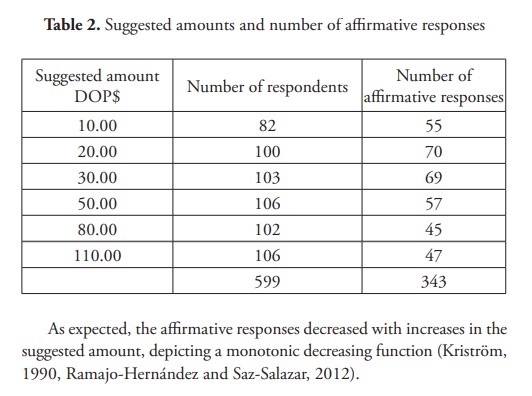
As expected, the affirmative responses decreased with increases in the suggested amount, depicting a monotonic decreasing function (Kriström, 1990, Ramajo-Hernández and Saz-Salazar, 2012).
3.1 Survival function
As stated before, the nonparametric estimation of WTP (np-WTP) is based on the definition of the survival function, obtained from the proportion of affirmative answers related to the amounts suggested as a payment vector (Kriström, 1990, Ramajo-Hernández and Saz-Salazar, 2012). Table 3 shows the proportion of affirmative responses obtained.
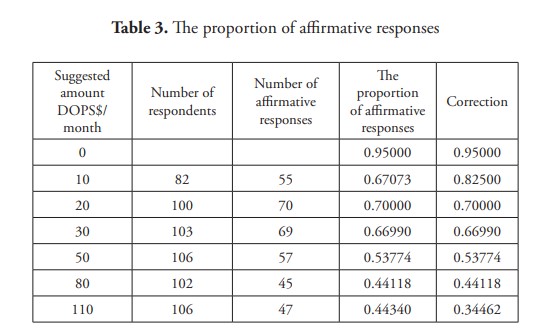
The last column was necessary to ensure that the survival function was monotonically decreasing (continuous line graph below) without affecting the estimation’s robustness (Kriström, 1990, Ramajo-Hernández and Saz-Salazar, 2012).
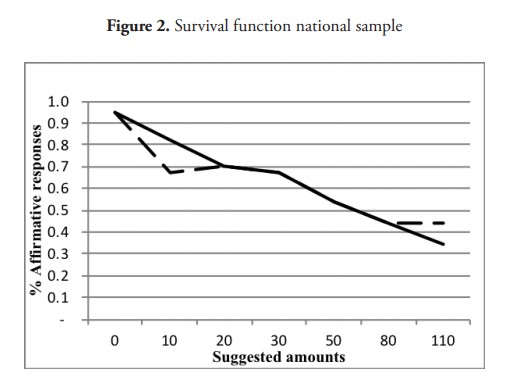
The average WTP is located in the area under the survival function associated with the proportion of affirmative responses (Kriström, 1990), which in this case is DOP$61.80/month (rounded to $62/per month), taking into account that the payment vehicle could be the monthly water bill. The median is calculated using a rule of thumb, as shown in Table 4.
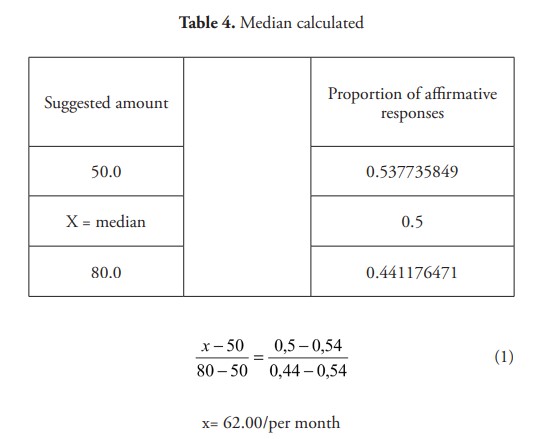
In equation 1 the average matches the median, and DOP$62 (around US$1.80) per month corresponded to the average monthly payment per family in 2007. The high level of rejection of the rock ash disposal is noteworthy because a higher level of rejection tends to indicate a greater WTP. To calculate the parametric estimation of WTP (p-WTP), a careful analysis of the database was necessary in order to define a more realistic and suitable econometric model that could explain the data. Table 5 shows the variables used in the logistic regression.

After several trials, a “yes” or “no” response model was run, and this final model was able to explain 66% of the variability in the data. The parametric WTP was estimated as DOP$80. Table 6 summarizes the results of the p-WTP.
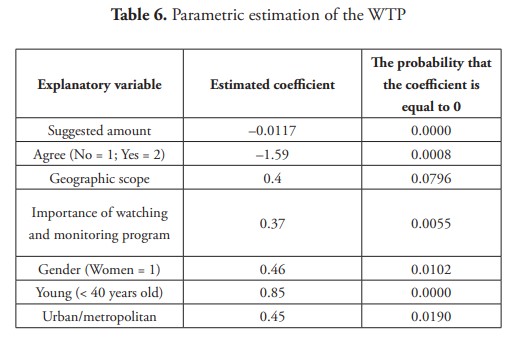
In the socio-economic and cultural context of the Dominican Republic, the nonparametric estimation seemed much more realistic than the parametric estimation. The parametric estimation reflects the effect of the high level of rejection of rock ash disposal by the population and could, therefore, lead to an overestimation of damages (Harrison, 2001, Liu et al., 2014, Carson et al., 2003).
3.2 Payment vehicles
It was proposed that a special fee would be paid through the regular water bill. The most significant proportion of respondents preferred this payment mechanism (39%), and a quarter of them would prefer a voluntary contribution. No significant statistical differences were found in relation to gender, age group, income level, or regional location. Respondents were asked about possible organizations to manage the WMP. It is interesting that 36% of respondents picked a non-existent organization (at least at the time that the fieldwork was carried out). National and local authorities each had the same degree of acceptability (20%). NGOs were preferred by 16% of respondents, and 5% preferred another decentralized organization (a public organization but ruled autonomously).
3.3 Aggregate level
The np-WTP corresponds to DOP$62 or US$1.80 in January 2007, which at the aggregate level and following similar cases (Carson et al., 2003, Tao et al., 2012, Adams et al., 2008), would depend on the total number of families, as follows:

In equation 2 DOP$62 is equal to WTP per month; DOP$62*12 is equal to the annual WTP; DOP$62*#DRfamilies*12 represents the aggregated level of society, and “r” represents the interbank interest rate on deposits in Dominican pesos. The total number of households in the Dominican Republic in 2006 was around 2,472,077, according to data from the Eighth National Census of 2002 (ONE, 2009, ONE, 2007), which implies that monthly payments are equal to DOP$153,268,774, which represents around US$4,575,187 per month. This amount corresponds to US$54,902,247 per year. It is essential to highlight that according to this estimate and taking into account that the WMP would last for four years, the value of environmental damage to the Dominican Republic, converted to the net present value (2006) using a LIBOR rate (5% annually), represents US$194,680,652 or around 0.5% of the Dominican GDP of 2006. Therefore, the total amount in US$ million could be considered as two measures: the amount that Dominican society would pay in order to prevent events like rock ash disposal, and the value of the welfare losses as it has been perceived by society.
3.4 Social perception of the rock ash case
After verifying respondents’ level of knowledge about the rock ash case, respondents were asked whether they would agree to allow the entry of rock ash into the Dominican Republic. 96.8% of them indicated that they would not agree, 1.5% said that they would agree, and 1.7% did not respond. Therefore, the high percentage of negative responses, with no significant differences in gender, age, or region, indicates a high rate of rejection of the government’s decision that allowed the rock ash into the Dominican Republic. Of the respondents, 50.8% pointed out significant impacts on quality of life, 40.5% noted significant impacts on the environment, and 8.7% noted significant impacts on productive activities.
At the regional level, distinct patterns of responses were observed: while in the metropolitan area (Santo Domingo) the impacts on the environment were considered significant (50.40%), in the eastern region (57.20%) and the south (68.0%) the impacts on quality of life emerged as the significant ones. However, in the north, where the two rock ash sites are located, both impacts on the environment (37.80%) and quality of life (48.10%) were considered significant. Concerning the perception about the magnitude of the environmental impacts, 83% considered it to be high, 13.5% considered it to be medium level, and only 3.5% considered it to be lower. Regarding the most affected locations, 59% stated that Samaná was the most affected, 8.1% Montecristi, and 32.6% the country as a whole, while 0.3% indicated that there were no significant impacts.
4. Concluding remarks
The CV exercise showed high levels of social rejection related to the decision that allowed the entry of rock ash into the Dominican territories, and the WTP for a WMP that would help to prevent and mitigate the environmental, economic, and social impacts in affected zones. This level of rejection also indicates a kind of referendum attitude in terms of social preferences. With the distance given by the passage of time, it could be argued that the high negative perception of Dominican society about rock ash discharge could be the result of the political and social situation of the moment. Nevertheless, social perception does not affect the technical and academic validity of the CV method. This is the same conclusion with international cases, such as the oil spill in the Gulf of Mexico in recent years (Bishop et al., 2017).
In terms of economic analysis of use and non-use values, it can be concluded that for this case, the use-values are related to the direct cost associated with landscape and environmental restoration at both sites. The non-use values are more related to the indirect cost in terms of negative externalities generated to tourism in the case of Samaná and quality of life in the case of Montecristi. Regarding the CV method, it provides accurate information about the stated preferences of members of Dominican society related to the outcomes of a non-optimal decision-making process in allowing the rock-ash discharge.
The final decision that led the government (through environmental authorities) in 2007 to settle for an amount that underestimated the passive social loss (indeed 3% of estimated losses) would miss the opportunity for better benefits for Dominican society. However, it also showed the importance of the economic valuation carried out rigorously as a tool to support the analysis of the gains and losses of environmental assets in a developing society such as the Dominican Republic.
5. Acknowledgments and conflict of interest
This paper should be considered as a report-based result aimed at disseminating the main empirical findings of the CV experience in the Dominican Republic as a decision tool for the former national environmental authorities. The detailed results of the environmental impact assessment can be found by request in Gómez-Valenzuela and Alpízar (2007). The authors would like to thank Joel Arboleda, Guillermo Milán Costa, Miguel Silva, and Angela Guerrero for their recommendations and technical and field support in different stages of the fieldwork. Thanks, are also owed to Dr. Max Puig, former Minister of Environment and Natural Resources of the Dominican Republic, who facilitated this research. The content of this paper is based on the rock ash report delivered in 2007. This paper does not imply a conflict of interest from the perspectives of the authors. Thanks to Dr. Yolanda Leon for the map template used in figure 1.
Referencias
ACAA. 2016. About Coal Ash [Online]. Farmington Hills, Michigan: American Coal Ash Association (ACAA). Available: https://www.acaa-usa.org/About-Coal-Ash/What-are-CCPs/Bottom-Ash[Accessed 08/09/2017 2017].
ADAMS, C., SEROA DA MOTTA, R., ARIGONI ORTIZ, R., REID, J., EBERSBACH AZNAR, C. & DE ALMEIDA SINISGALLI, P. A. 2008. The use of contingent valuation for evaluating protected areas in the developing world: Economic valuation of Morro do Diabo State Park, Atlantic Rainforest, São Paulo State (Brazil). Ecological Economics, 66, 359-370.
AKHTAR, S., SALEEM, W., NADEEM, V. M., SHAHID, I. & IKRAM, A. 2017. Assessment of willingness to pay for improved air quality using contingent valuation method. Global Journal of Environmental Science and Management, 3, 279-286.
ATTALI, J. 2010. República Dominicana 2010-2030. Santo Domingo: Ministerio de Economía, Planificación y Desarrollo.
BANCO-CENTRAL. 2017. Estadísticas económicas [Online]. Santo Domingo, D. N.: Banco Central de la República Dominciana. Available: https://www.bancentral.gov.do/estadisticas_economicas/real/ [Accessed 30/08/2017 2017].
BISHOP, R. C., BOYLE, K. J., CARSON, R. T., CHAPMAN, D., HANEMANN, W. M., KANNINEN, B., KOPP, R. J., KROSNICK, J. A., LIST, J., MEADE, N., PATERSON, R., PRESSER, S., SMITH, V. K., TOURANGEAU, R., WELSH, M., WOOLDRIDGE, J. M., DEBELL, M., DONOVAN, C., KONOPKA, M. & SCHERER, N. 2017. Putting a value on injuries to natural assets: The BP oil spill. Science, 356, 253-254.
BISHOP, R. C. & HABERLEIN, T. A. 1979. Measuring values of extra-market goods: Are indirect measures biased?. American Journal of Agricultural Economics, 61, 926-930.
CARSON, R. T. 2012. Contingent Valuation: A Practical Alternative when Prices Aren’t Available. Journal of Economic Perspectives, 26, 27-42.
CARSON, R. T., FLORES, N. E., MARTIN, K. M. & WRIGHT, J. L., 1996. Contingent valuation and revealed preference methodologies: comparing the estimates for quasi-public goods. Land Economics, 72, 80-99.
CARSON, R. T., MITCHEL, R. C., HANEMANN, M., KOPP, R. J., PRESSER, S. & RUUD, P. A. 2003. Contingent Valuation and Lost Passive Use: Damages from the Exxon Valdez Oil Spill. Environmental and Resource Economics, 25, 257-286.
DAVIS, R. K. 1963. The Value of Outdoor Recreation: An Economic Study of the Maine Woods. Doctoral PhD Dissertation, Harvard.
DE LEÓN, O. 2009. Rockash y contaminación ambiental [Online]. Santo Domingo, D. N.: Grupo de Medio Corripio. Available: http://eldia.com.do/rockash-y-contaminacion-ambiental-2/ [Accessed 08/09/2017 2017].
EPA. 2017a. Coal Ash Basics [Online]. Washington, D. C.: Environmental Protection Agency (EPA). Available: https://www.epa.gov/coalash/coal-ash-basics [Accessed 08/09/2017 2017].
EPA. 2017b. Law & Regulations [Online]. Washington, D. C.: Environmental Protection Agency (EPA). Available: https://www.epa.gov/laws-regulations/summary-comprehensive-environmental-response-compensation-and-liability-act [Accessed 09/09/2017 2017].
FREEMAN, A. M., III, HERRIGES, J. A. & KLING, C. L. 2014. The Measurement of Environmental and Resource Values, New York, U.S.A., RFF Press.
GÓMEZ-VALENZUELA, V. & ALPÍZAR, F. 2007. Valoración económica de los impactos ambientales causados por la disposición del rockash en la República Dominicana. Santo Domingo, D. N.: Secretaría de Estado de Medio Ambiente y Recursos Naturales.
HANEMANN, W. M. 1994. Valuing the environment through contingent valuation. The Journal of Economic Perspectives, 8, 19-43.
HARRISON, G. W. 2001. Contingent Valuation Meets the Experts: A Critique of the NOAA Panel Report. Columbia, SC. USA: University of South Carolina.
HARRISON, G. W. 2006. Assesing damages for the Exxon Valdez Oil Spill. University of Central Florida, Orlando, FL.: University of Central Florida.
KRISTRÖM, B. 1990. A non-parametric approach to the estimation of welfare measures in discrete response valuation studies. Land Economics, 66, 135-139.
L. NANDAGIRI, J. 2015. Evaluation of Economic Value of Pilikula Lake using Travel Cost and Contingent Valuation Methods. Aquatic Procedia, 4, 1315-1321.
LIU, C.-C., HERRIGES, J. A., KLING, C. L., SECCHI, S., NASSAUER, J. I. & PHANEUF, D. J. 2014. A Comparison of Value Elicitation Question Formats in Multiple-Good Contingent Valuation. Frontiers of Economics in China, 9, 85-108.
MAHIEU, P.-A., RIERA, P., KRISTRÖM, B., BRÄNNLUND, R. & GIERGICZNY, M. 2014. Exploring the determinants of uncertainty in contingent valuation surveys. Journal of Environmental Economics and Policy, 3, 186-200.
MEPYD 2016. Análisis del Desempeño Económico y Social de República Dominicana 2015. Santo Domingo, D. N.: Ministerio de Economía, Planificación y Desarrollo (MEPyD).
ONE 2007. ENHOGAR 2007. Encuesta Nacional de Hogares de Propósitos Múltiples Santo Domingo, D. N.: Oficina Nacional de Estadística (ONE).
ONE. 2009. Censo Nacional 2002. Vol. II Características de Viviendas y Hogares [Online]. Santo Domingo, D. N. : Oficina Nacional de Estadística (ONE). Available: https://www.one.gob.do/Estadisticas/265/censo-2002 [Accessed 12/09/2017 2017].
ONE 2012. División Territorial 2012. Santo Domingo, D. N.: Oficina Nacional de Estadística (ONE).
PORTNEY, P. R. 1994. The contingent valuation debate: why economists should care. The Journal of Economic Perspectives, 8, 3-17.
RAMAJO-HERNÁNDEZ, J. & SAZ-SALAZAR, S. D. 2012. Estimating the non-market benefits of water quality improvement for a case study in Spain: A contingent valuation approach. Environmental Science and Policy, 47-59.
SCHEAFFER, R. L., MENDENHALL III, W., OTT, R. L. & GEROW, K. G. 2011. Elementary Survery Sampling Florence, KY, United States, Cengage Learning, Inc.
TAO, Z., YAN, H. & ZHAN, J. 2012. Economic Valuation of Forest Ecosystem Services in Heshui Watershed using Contingent Valuation Method. Procedia Environmental Services, 13, 2445-2450.
UNDP 2016. Human Development Report 2016. Human Development for Everyone. New York, USA: United Nations Development Programme.
VOLTAIRE, L., PIRRONE, C. & BAILLY, D. 2013. Dealing with preference uncertainty in contingent willingness to pay for a nature protection program: A new approach. Ecological Economics, 88, 76-85.
WHITTINGTON, D. 1998. Administering Contingent Valuation Surveys in Developing Countries. World Development, 26, 21-30.
WORLD-BANK. 2017. Data Bank [Online]. Washington, D. C.: World Bank. Available: http://databank.bancomundial.org/data/reports.aspx? [Accessed 30/08/2017 2017].

